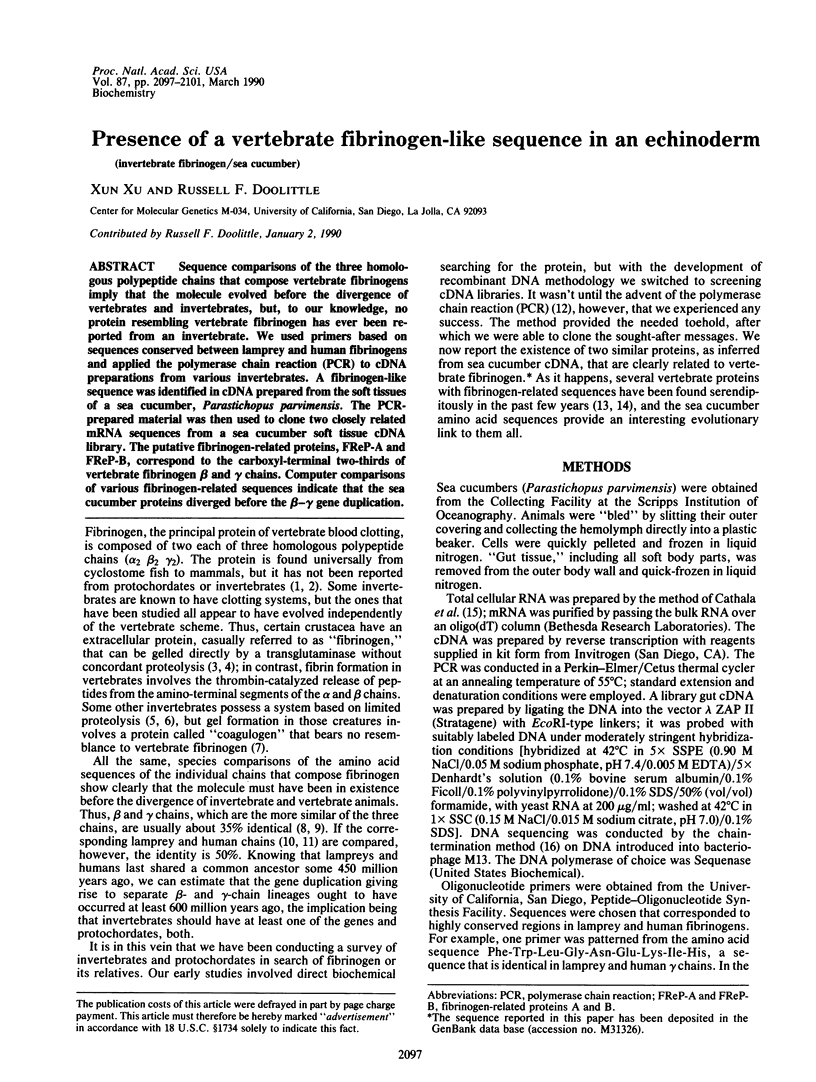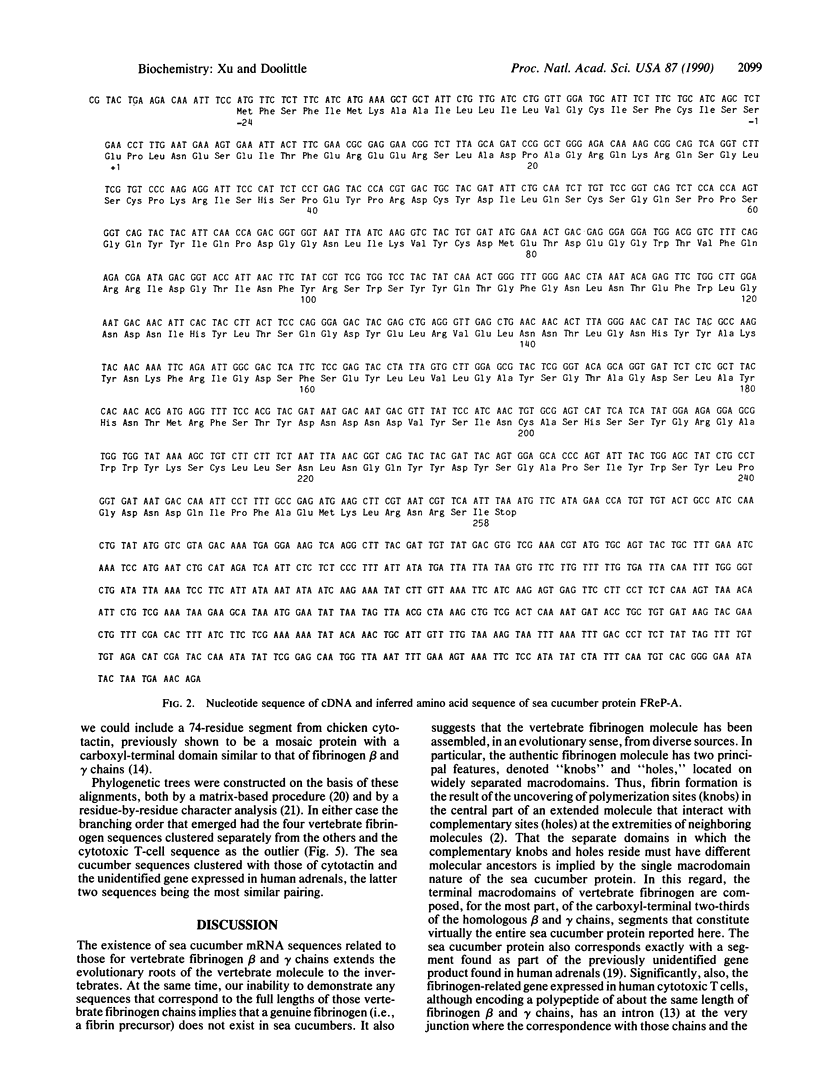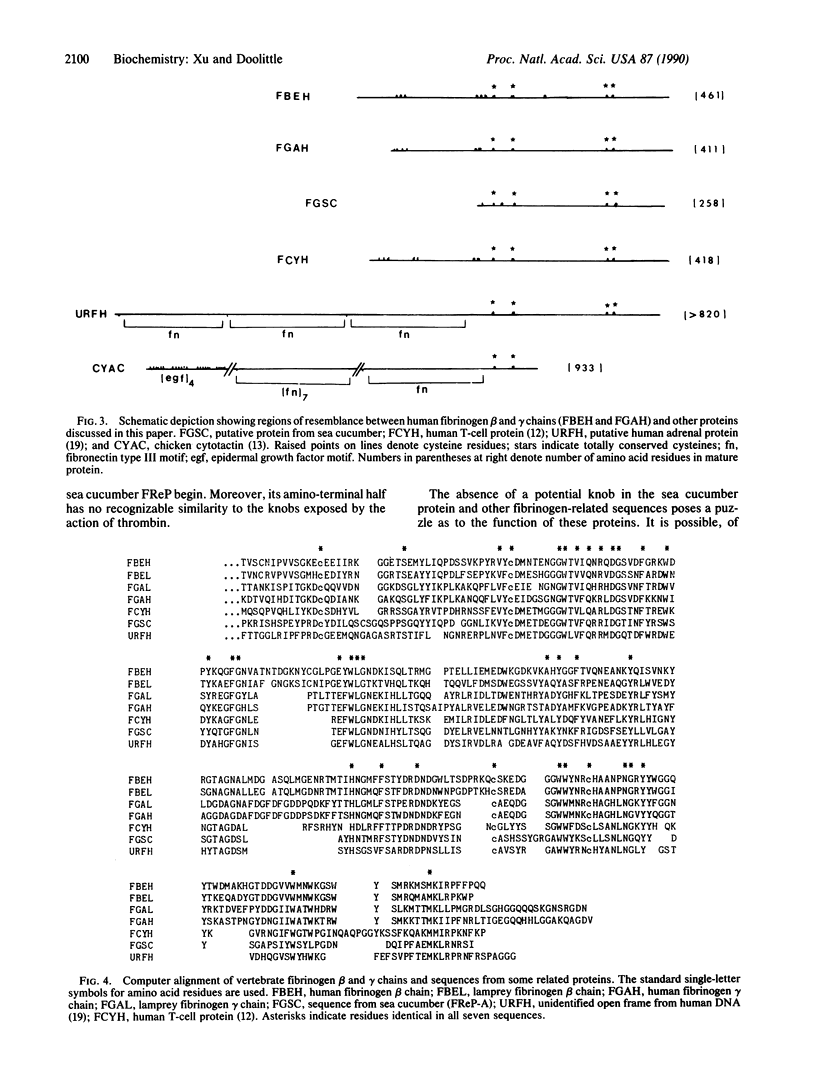Abstract
Sequence comparisons of the three homologous polypeptide chains that compose vertebrate fibrinogens imply that the molecule evolved before the divergence of vertebrates and invertebrates, but, to our knowledge, no protein resembling vertebrate fibrinogen has even been reported from an invertebrate. We used primers based on sequences conserved between lamprey and human fibrinogens and applied the polymerase chain reaction (PCR) to cDNA preparations from various invertebrates. A fibrinogen-like sequence was identified in cDNA prepared from the soft tissues of a sea cucumber, parastichopus parvimensis. The PCR-prepared material was then used to clone two closely related mRNA sequences from a sea cucumber soft tissue cDNA library. The putative fibrinogen-related proteins, FReP-A and FReP-B, correspond to the carboxyl-terminal two-thirds of vertebrate fibrinogen beta and gamma chains. Computer comparisons of various fibrinogen-related sequences indicate that the sea cucumber proteins diverged before the beta-gamma gene duplication.
Full text
PDF




Selected References
These references are in PubMed. This may not be the complete list of references from this article.
- Bohonus V. L., Doolittle R. F., Pontes M., Strong D. D. Complementary DNA sequence of lamprey fibrinogen beta chain. Biochemistry. 1986 Oct 21;25(21):6512–6516. doi: 10.1021/bi00369a026. [DOI] [PubMed] [Google Scholar]
- Cathala G., Savouret J. F., Mendez B., West B. L., Karin M., Martial J. A., Baxter J. D. A method for isolation of intact, translationally active ribonucleic acid. DNA. 1983;2(4):329–335. doi: 10.1089/dna.1983.2.329. [DOI] [PubMed] [Google Scholar]
- Chiquet-Ehrismann R., Mackie E. J., Pearson C. A., Sakakura T. Tenascin: an extracellular matrix protein involved in tissue interactions during fetal development and oncogenesis. Cell. 1986 Oct 10;47(1):131–139. doi: 10.1016/0092-8674(86)90374-0. [DOI] [PubMed] [Google Scholar]
- Doolittle R. F., Feng D. F. Nearest neighbor procedure for relating progressively aligned amino acid sequences. Methods Enzymol. 1990;183:659–669. doi: 10.1016/0076-6879(90)83043-9. [DOI] [PubMed] [Google Scholar]
- Doolittle R. F. Fibrinogen and fibrin. Annu Rev Biochem. 1984;53:195–229. doi: 10.1146/annurev.bi.53.070184.001211. [DOI] [PubMed] [Google Scholar]
- Doolittle R. F., Fuller G. M. Sodium dodecyl sulfate-polyacrylamide gel electrophoresis studies on lobster fibrinogen and fibrin. Biochim Biophys Acta. 1972 May 18;263(3):805–809. doi: 10.1016/0005-2795(72)90064-5. [DOI] [PubMed] [Google Scholar]
- Doolittle R. F. The structure and evolution of vertebrate fibrinogen. Ann N Y Acad Sci. 1983 Jun 27;408:13–27. doi: 10.1111/j.1749-6632.1983.tb23231.x. [DOI] [PubMed] [Google Scholar]
- Erickson H. P., Taylor H. C. Hexabrachion proteins in embryonic chicken tissues and human tumors. J Cell Biol. 1987 Sep;105(3):1387–1394. doi: 10.1083/jcb.105.3.1387. [DOI] [PMC free article] [PubMed] [Google Scholar]
- Feinberg A. P., Vogelstein B. A technique for radiolabeling DNA restriction endonuclease fragments to high specific activity. Anal Biochem. 1983 Jul 1;132(1):6–13. doi: 10.1016/0003-2697(83)90418-9. [DOI] [PubMed] [Google Scholar]
- Feng D. F., Doolittle R. F. Progressive sequence alignment as a prerequisite to correct phylogenetic trees. J Mol Evol. 1987;25(4):351–360. doi: 10.1007/BF02603120. [DOI] [PubMed] [Google Scholar]
- Fuller G. M., Doolittle R. F. Studies of invertebrate fibrinogen. II. Transformation of lobster fibrinogen into fibrin. Biochemistry. 1971 Apr 13;10(8):1311–1315. doi: 10.1021/bi00784a006. [DOI] [PubMed] [Google Scholar]
- Henschen A., Lottspeich F. Sequence homology between gamma-chain and beta-chain in human fibrin. Thromb Res. 1977 Dec;11(6):869–880. doi: 10.1016/0049-3848(77)90115-3. [DOI] [PubMed] [Google Scholar]
- Jones F. S., Burgoon M. P., Hoffman S., Crossin K. L., Cunningham B. A., Edelman G. M. A cDNA clone for cytotactin contains sequences similar to epidermal growth factor-like repeats and segments of fibronectin and fibrinogen. Proc Natl Acad Sci U S A. 1988 Apr;85(7):2186–2190. doi: 10.1073/pnas.85.7.2186. [DOI] [PMC free article] [PubMed] [Google Scholar]
- Koyama T., Hall L. R., Haser W. G., Tonegawa S., Saito H. Structure of a cytotoxic T-lymphocyte-specific gene shows a strong homology to fibrinogen beta and gamma chains. Proc Natl Acad Sci U S A. 1987 Mar;84(6):1609–1613. doi: 10.1073/pnas.84.6.1609. [DOI] [PMC free article] [PubMed] [Google Scholar]
- Levin J., Bang F. B. Clottable protein in Limulus; its localization and kinetics of its coagulation by endotoxin. Thromb Diath Haemorrh. 1968 Mar 31;19(1):186–197. [PubMed] [Google Scholar]
- Morel Y., Bristow J., Gitelman S. E., Miller W. L. Transcript encoded on the opposite strand of the human steroid 21-hydroxylase/complement component C4 gene locus. Proc Natl Acad Sci U S A. 1989 Sep;86(17):6582–6586. doi: 10.1073/pnas.86.17.6582. [DOI] [PMC free article] [PubMed] [Google Scholar]
- Saiki R. K., Scharf S., Faloona F., Mullis K. B., Horn G. T., Erlich H. A., Arnheim N. Enzymatic amplification of beta-globin genomic sequences and restriction site analysis for diagnosis of sickle cell anemia. Science. 1985 Dec 20;230(4732):1350–1354. doi: 10.1126/science.2999980. [DOI] [PubMed] [Google Scholar]
- Sanger F., Nicklen S., Coulson A. R. DNA sequencing with chain-terminating inhibitors. Proc Natl Acad Sci U S A. 1977 Dec;74(12):5463–5467. doi: 10.1073/pnas.74.12.5463. [DOI] [PMC free article] [PubMed] [Google Scholar]
- Strong D. D., Moore M., Cottrell B. A., Bohonus V. L., Pontes M., Evans B., Riley M., Doolittle R. F. Lamprey fibrinogen gamma chain: cloning, cDNA sequencing, and general characterization. Biochemistry. 1985 Jan 1;24(1):92–101. doi: 10.1021/bi00322a014. [DOI] [PubMed] [Google Scholar]
- Tokunaga F., Miyata T., Nakamura T., Morita T., Kuma K., Miyata T., Iwanaga S. Lipopolysaccharide-sensitive serine-protease zymogen (factor C) of horseshoe crab hemocytes. Identification and alignment of proteolytic fragments produced during the activation show that it is a novel type of serine protease. Eur J Biochem. 1987 Sep 15;167(3):405–416. doi: 10.1111/j.1432-1033.1987.tb13352.x. [DOI] [PubMed] [Google Scholar]
- Watt K. W., Takagi T., Doolittle R. F. Amino acid sequence of the beta chain of human fibrinogen: homology with the gamma chain. Proc Natl Acad Sci U S A. 1978 Apr;75(4):1731–1735. doi: 10.1073/pnas.75.4.1731. [DOI] [PMC free article] [PubMed] [Google Scholar]
- von Heijne G. A new method for predicting signal sequence cleavage sites. Nucleic Acids Res. 1986 Jun 11;14(11):4683–4690. doi: 10.1093/nar/14.11.4683. [DOI] [PMC free article] [PubMed] [Google Scholar]


